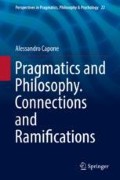Abstract
In this paper, I deal with implicit indirect reports. First of all, I discuss implicit indirect reports involving the first person. Then, I prove that in some cases second person reports are implicit indirect reports involving a de se attribution. Next, I draw analogies with implicit indirect reports involving the third person. I establish some similarities at the level of free enrichment through which the explicature is obtained and I propose that the explicature is syntactically active, given that it sanctions anaphora.
I first considered the issue of implicit indirect reports when reading a paper by Elizabeth Holt that was submitted for my collection on indirect reports and pragmatics (Springer 2016). There was little discussion about implicit indirect reports because the focus was on indirect reports in general, but there was sufficient to allow me to give some consideration to this topic in Capone (2016) (implicit embeddings), and now in the present chapter.
Access this chapter
Tax calculation will be finalised at checkout
Purchases are for personal use only
Notes
- 1.
Although, in some cases, semantics appears to be like an instruction which takes context as input, in a particular way, and gives a specific truth-evaluable content as output.
- 2.
Semantics provides a platform on which further meanings can be constructed. Most importantly, the unenriched logical form is capable of working as a premise in an act of reasoning which is conducive to fuller interpretation, provided that basic operations such as reference fixing and disambiguation have occurred.
- 3.
Synthetically, rationality is what leads to processes of reflective and unreflective inference in which a number of premises, including the literal meaning and the disseminated contextual clues, are put together (combined) in an argument that leads to a full interpreted proposition. The Gricean maxims or suitable equivalents (in expanded or compressed form) also work as premises in the argument. Since in an argument, we normally need something that leads from a set of premises to a conclusion, that is, a warrant, we can assume that in pragmatic inference the role of the warrant is played by the necessity of having speakers’ intentions that obey canons of informativity.
- 4.
Some believe that verbatim direct reports are a fiction, given that due to memory limitations we always make changes in the reported utterance. However, it should be taken for granted that, at least in the written medium, verbatim quotation does makes sense.
- 5.
Interesting interpretative issues emerge. Is (6) equivalent to ‘I remember I never wanted to jump off the swing’? The other interpretative possibility is: ‘I remember never wanting to jump off the swing’, which is even more first-personal than the former interpretation. As Higginbotham (2003) would state, the latter interpretation is more logophoric in that it involves the internal perspective of the speaker qua the experience and subject of the act of remembering.
- 6.
Vividness should be taken to be an inferential syntactic structure which is associated with past tense reports (especially second person reports) requiring a logophoric interpretation. The structure is hosted through the syntactic device of a relative clause construction in an event which is implicit in the semantic/syntactic analysis of the main verb expressing the substance of the report, while we can say that the implicit event of the semantic analysis (a Davidsonian event structure) potentially hosts the syntactic construction that expresses vividness. A vividness implicit structure must be triggered by a number of contextual clues that say something about the participation of the speaker in the reported event.
- 7.
It is most interesting that these considerations conform with Jaszczolt’s (2016) view that “both I and you can be regarded as pertaining to modes of reference de se or self- ascription” (her argument is that when one attributes a quality (or predicate) to the second person, the attribution must be recovered by the addressee by using the first person).
References
Capone Alessandro (2003). On Grice’s circle. RASK: International Journal of Language and Communication 19, 3–32.
Capone Alessandro (2006). On Grice’s circle. Journal of Pragmatics 38, 645–669.
Capone, Alessandro. 2008. Belief reports and pragmatic intrusion. The case of null appositives. Journal of Pragmatics 40(6):1019–1040.
Capone Alessandro (2009). Are explicatures cancellable? Towards a theory of the speaker’s intentionality. Intercultural Pragmatics 6/1, 55–83.
Capone, Alessandro (2010). “Between Scylla and Charibdis”: The semantics and pragmatics of attitudes ‘de se’. “Journal of Intercultural Pragmatics” 7/3, 471–503.
Capone (2013). https://philpapers.org/rec/CAPCOT
Capone, Alessandro (2016). The pragmatics of indirect reports. Socio-philosophical considerations. Cham, Springer.
Capone Alessandro, Kiefer, Ferenc, Lo Piparo, Franco, eds. (2016). Indirect reports and pragmatics. Cham, Springer.
Carston, Robyn (2002). Thoughts and utterances. The pragmatics of explicit communication. Oxford, Blackwell.
Elisabeth Holt (2016). Indirect Reported Speech in Interaction, 167–187. In https://link.springer.com/book/10.1007%2F978-3-319-21395-8
Higginbotham, James (2003). Remembering, imagining and the first person. In A. Barber, ed. Epistemology of language. Oxford, OUP, 496-533.
Jaszczolt, K. (2016). Pragmatic indexicals. In M. Huang, K. M. Jaszczolt, eds. Expressing the self: Cultural diversity and cognitive universals. Oxford, OUP.
Peacocke, Christopher (2014). Subject, consciousness and self-consciousness. Oxford, OUP.
Saul, Jennifer (2007). Simple sentences, substitution and intuitions. Oxford, OUP.
Author information
Authors and Affiliations
Rights and permissions
Copyright information
© 2019 Springer Nature Switzerland AG
About this chapter
Cite this chapter
Capone, A. (2019). First Person Implicit Indirect Reports. In: Pragmatics and Philosophy. Connections and Ramifications. Perspectives in Pragmatics, Philosophy & Psychology, vol 22. Springer, Cham. https://doi.org/10.1007/978-3-030-19146-7_10
Download citation
DOI: https://doi.org/10.1007/978-3-030-19146-7_10
Published:
Publisher Name: Springer, Cham
Print ISBN: 978-3-030-19145-0
Online ISBN: 978-3-030-19146-7
eBook Packages: Social SciencesSocial Sciences (R0)

